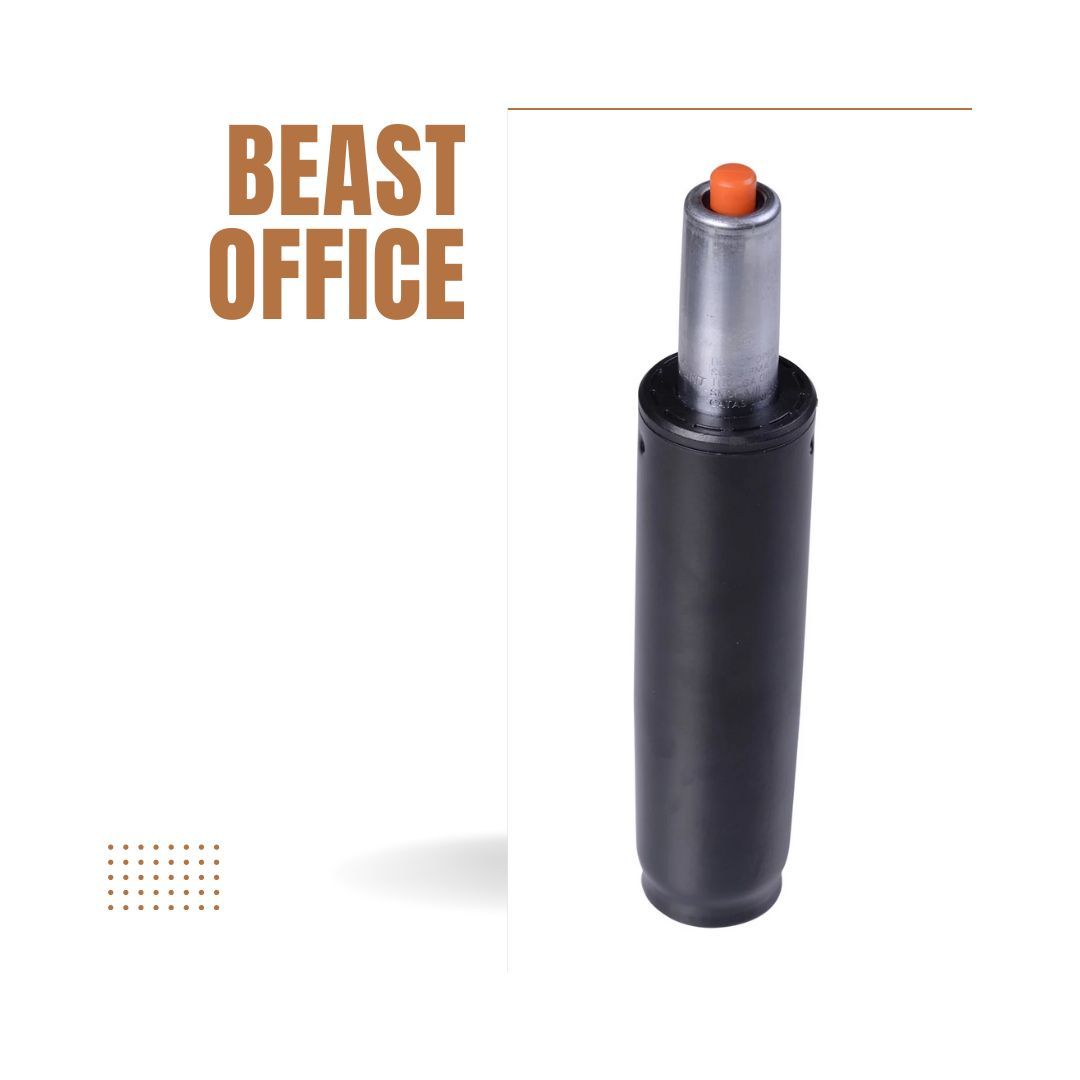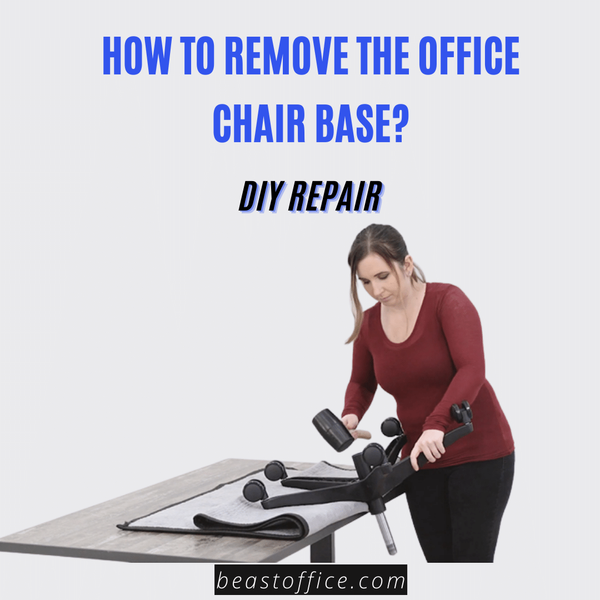This pressure pushes against a spring which causes your seat to raise until it reaches its full height (or until another stop begins activating). This process is reversed when you let go of your armrest. As soon as no pressure is applied to the spring, it pushes down and forces air back into your cylinder until it reaches its original position again.
Here are some common problems that occur:
The Gas Lift Does Not Work at All
If your gas lift does not work, this is usually due to a problem with the gas cylinder or the chain that pulls it up and down.
The Gas Lift Only Goes Part Way Up
If your chair will only go part way up when you press down on it and try moving it, then there is likely an issue with either the chain or the gas cylinder itself. The chain connects directly to these two parts, so if one breaks or wears out, it could prevent them from working properly together as one unit.
This blog post will show you how to remove the gas lift cylinder from your office chair. We will also provide tips on choosing a replacement gas lift cylinder.
How To Remove Office Chair Cylinder?

Ways to Fix the Gas Lift on an Office Chair
There are several ways to fix a broken gas lift on an office chair. Many people try to do it themselves, but sometimes it's best to call in an expert.
Inspect the Cylinder
Remove the screws holding down the seat pad, then pull off the seat pad to expose the gas lift cylinder. Look for signs of damage or wear on the cylinder. Cracks or bulges in the metal indicate that it has been damaged beyond repair and needs replacement. If there are no cracks or bulges but you notice a lot of dirt and grime inside the cylinder, clean out as much as possible with an old toothbrush dipped in soapy water. Dry it thoroughly before reassembling everything again.
Check for Leaks
You'll want to check for leaks in the seal between the piston and cylinder by placing a rag underneath it and pressing down on it with your hand. There should be no leaks if there's no pressure on the piston (from you pressing down on it). If there are leaks, you'll need to replace this part before proceeding with further repairs.
Wrap A Hose Clamp
If you want to give it a try first, there are some steps you can take before calling in someone else to help. One option is to wrap a hose clamp around the top of your gas cylinder and tighten it until it stops moving up and down freely. You'll need two clamps for this method — one at each end of the cylinder — but if it works, great!
Use A PVC Pipe
Another option is to use a PVC pipe or other tube instead of a hose clamp. You'll need two pieces of tubing, one long enough to reach from one end of your cylinder to the other and another shorter piece that fits inside the first one so they're connected tightly enough not to come apart while you're using them together on your chair.
Wrap A Hose Clamp
A hose clamp is one of those things that every household should have anyway because it can come in handy for so many different things. One of those uses is fixing an office chair gas lift cylinder! You can wrap a hose clamp around the base of your broken cylinder to keep it from falling out entirely until you get it replaced or repaired professionally.
What Are The Steps To Follow While Removing Office Chair Cylinder
1. Remove the screws on the chair's base using a screwdriver. There are usually four screws, which can be found in different places. One screw is located at the back of the chair, two are on each side, and one is on the front (this one is usually hidden by fabric).
2. Once you have removed all four of these screws, pull out the base from underneath and place it on one side for now.
3. The next step is to remove the top part of your old cylinder from its seat attached to your chair's frame. To do this, you must unscrew two bolts with an Allen key (these bolts are located at either end of your seat).
4. Once these are removed, you can pull up on this top part of your old cylinder and remove it entirely from your chair's frame.
Install The New Cylinder in Your Office Chair
The last step in installing new office chair cylinders is installing new ones in your office chairs so that they work properly again when someone sits down.
This can be done by turning the cylinder on its side and inserting it into the hole in the bottom of your office chair seat. Some people may find this easier if they use a hammer to tap it into place.
Once you have installed your new cylinder, you should be able to test it and ensure it works properly by sitting down on it. If your chair seems to be moving too easily as you sit down, you should tighten up the nut that holds everything together before trying again.
Gas Lift Cylinder As an Important Feature
The office chair is one of the most important piece of furniture in any work environment. Not only does it provide a comfortable place to sit, but it also plays a crucial role in ergonomics and productivity.
When it comes to office chairs, there are a variety of different designs and features to choose from. One of the most important features of an office chair is the gas lift cylinder. The gas lift cylinder is responsible for adjusting the height of the chair. Over time, the gas lift cylinder can become worn out and must be replaced.
Reasons May Cause to Remove Office Chair Cylinder

There are many reasons why a cylinder might need to be replaced.
Cylinder is Leaking
The most common reason is if the cylinder is leaking. The most common type of leak is when there is a hole in the piston seal or when the rubber seal has completely worn out and needs to be replaced.
This can be caused by over-tightening or misalignment of the piston and rod, which puts pressure on these seals, causing them to wear out quickly.
Office Chair Cylinder Replacement Kit With Removal Tools And Instructions
Chair Cylinder Replacement Kit includes:
- New chair cylinder with instructions and tools
- New screws
- New washers
- New nuts
Simply follow the instructions included in your package to complete the installation:
- The kit contains everything you need to repair your office chair. It includes a new cylinder, the core part of the mechanism that allows you to adjust the chair's height and rock back and forth. This is an OEM part made by the manufacturer of your office chair. If you want to repair your chair, this is where to start!
- This kit comes with a new cylinder, two screws (1/4"x20), two flat washers, and instructions on installing it. Some chairs can also use a gasket (not included), but most don't need it because they have rubber-sealed cylinders that prevent dust from entering the mechanism.
What Are The Preventive Measures While Removing Office Chair Cylinder?
Before you remove the office chair cylinder, here are some preventive measures to take:
- Do not use a hammer or other hard object to loosen the nuts. Doing so can damage your chair and make it unsafe to sit on.
- Use a wrench to loosen the nuts but be careful not to use too much force as this might cause damage to the pipes as well.
- If you have trouble tightening them back after removing the cylinder, apply thread lock adhesive on them before installing them again.
Remove The Office Chair Cylinder Without The Wrench
If you don't have a wrench, use pliers or vice grips. You may need a hammer if these tools need to be stronger to loosen the nut.
When you remove the cylinder from your office chair, ensure it is empty before putting it back in place.
What If You Can't Remove The Cylinder From An Office Chair?
If you're trying to remove the cylinder from a chair and you're having trouble, there are a few things you can do.
- One thing you can do is take the cylinder out of the seat to get to it better. If this isn't an option, try to heat the cylinder with a hair dryer or heat gun. Be careful not to get too close to these items because they could cause damage if they come too close to the plastic casing around your cylinder.
- Another thing that you can do is simply spray some lubricant on your cylinder and the inside of your chair seat. This will help loosen up any rust or corrosion that may be present on either part of your cylinder or inside of your chair seat.
How To Determine the Size of the Cylinder For Office Chair?
To determine the size of your cylinder, you need to measure its diameter, length, width, depth, and height. If you have not done so, read through the instructions for removing your current chair cylinder to get familiar with the process before attempting it on your own.
How To Mark the Office Chair Cylinder?
- Mark the cylinder. Use a permanent marker to mark the cylinder in a way that makes it easy to identify, such as by marking at each end's top, middle, and bottom.
- Inspect for damaged areas. Check if any damaged areas on your chair's cylinder assembly or other parts may be causing problems with your chair's operation. If there are any damages, contact an office-chair repair specialist to have them repaired.
How To Break the Seal on the Cylinder Of an Office Chair?
If you're looking for a way to break the seal on an office chair cylinder, a few tools might help. You mustn't use a screwdriver or chisel.
A hammer is one of the best ways to break the seal, but remember that sometimes this might damage your cylinder and make it harder to remove.
- Use a hammer and tap each side of your rachet head until it breaks off.
- If this doesn't work, try using vise grips—these may do the trick.
How To Take Out the Piston Rod Of Office Chair Cylinder?
To remove the piston rod, use a hammer and chisel to break the seal between the piston rod and cylinder. Once you have access to the piston rod, could you remove it from both ends of your chair? Clean all parts thoroughly and store them in an airtight container until you can put everything back together.
Remove debris inside your chair's cylinder with a soft brush or rag before reinserting it back into its original location on top of the base plate.
Use a wrench if necessary to secure it tightly in place so that it cannot move around freely while you're working on other aspects of cleaning or repairing your office chair's mechanism later on (like replacing worn-out wheels).
An office chair cylinder is not difficult to remove but takes time and preparation
If you are experiencing problems with the cylinder in your office chair, then it is time to consider replacing it. Replacing an office chair cylinder is not difficult, but you should do a few things before removing it to get the most out of this process.
First, ensure that the cylinder is not working properly by testing it on its own. If there are no problems with this piece of equipment and only issues arise when it comes into contact with the chair itself, then replacing both parts may be necessary.
However, if testing shows no issues with either component individually (or if one component does work well), then only replace what needs replacing. Either replace just your old cylinder or buy new ones for both pieces together (as long as they're compatible).
What If The Office Chair Cylinder Gets Stuck In The Base?
You can do a few things if you have an office chair that has stopped rolling because of a stuck cylinder. First, try to get the chair moving again by pushing it forward and backward while leaning on it. If this doesn't work, try putting some WD-40 or other lubricants on the cylinder and rotating it back and forth with your hand. If this doesn't work, then you will need to take apart your chair and remove the base to get at the stuck cylinder.
What If The Gas Lift Chair Gets Stuck In The Up Position?
When the gas lift chair is stuck in the up position, or if it seems to be getting stuck more often than usual, there are several things that you can do to try and fix the problem.
- First, check to see if the cylinder is leaking. If so, it can be repaired or replaced quickly.
- If there is no sign of leakage, check the height adjustment knob on your chair. If this is loose or has come loose from its stem assembly, tighten it back into place with either a screwdriver or an Allen key.
- If these solutions don't work, your gas lift cylinder may need to be replaced. This is an easy process with most models of chairs; follow your owner's manual instructions for returning your cylinder.
Conclusion
The cylindrical mechanism inside the chair can be removed very easily. First, loosen the screws holding the seat height adjustment lever and remove it. Remove the padding from the backrest. Set an ordinary screwdriver in the top piece of wood on the back cover and turn it anticlockwise about one and a half rounds or two circles to get it loose. Then remove the remaining screws along with their washers, carefully separating all parts of each fastener. Finally, loosen the screws on each side of the seat back and remove both armrest pads. With this, you can remove all components that need to be dismounted. Then you can take apart all. Place loose parts one by one into a plastic box so they will not get lost.
Related Posts








